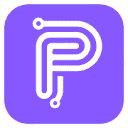When interacting with AI tools such as ChatGPT and Midjourney, most users still rely on “trial-and-error” cue creation, resulting in uneven quality of the output. Through systematic tutorials, practical cases and interactive communities, it helps users master the underlying logic of prompt design and realize the leap from “passive use” to “active mastery” of AI. Whether they are AI beginners, content creators, or corporate professionals, they can use platform resources to increase AI interaction efficiency by more than 80%, so that the model output can accurately match the actual needs.
Learning Prompt is different from ordinary prompt sharing tools, its core value is to build a complete learning closed loop of “principle analysis – case verification – practice landing”, and accurately solve the fundamental pain point of users “not knowing how to design effective prompts”:
The platform takes Chinese content as the core, taking into account English support, and customizes the teaching content for Chinese users’ expression habits and usage scenarios, completely breaking the language barrier:
- Layered teaching system: Covering all stages of learning needs from basic to advanced, the basic chapter explains the core elements of cues (role, context, instructions, etc.), while the advanced chapter goes deeper into Few-Shot cues, chain of thought reasoning and other professional skills, ensuring that users with different basics can find appropriate content;
- Methodology visualization: the complex Prompt project is broken down into reusable frameworks, such as the CRISPE framework (Competencies and Roles, Specific Requests, Contextual Insights, Detailed Statements, Personalities and Styles, Experimentation and Formatting), which allows users to quickly grasp the structured prompt design methodology through “Conceptual Explanation + Comparison of Examples”;
- Professional content review: all tutorials and cases are proofread by educational experts and scholars to ensure the professionalism and reliability of knowledge and avoid misleading content affecting the learning effect.
The platform abandons pure knowledge instillation, through the “tutorial learning – case imitation – self-creation” path design, allowing users to deepen their understanding in practice:
- Practical case library: covering multiple scenarios such as education, creative writing, academic research, corporate office, etc., such as the design of prompts for generating lesson plans in the field of education, and the framework of high-conversion copywriting in the field of e-commerce, etc., with each case containing a complete analysis of “original prompts – optimization ideas – final results”;
- Interactive Learning Support: Provide prompts practice tasks and feedback mechanism, users can upload self-designed prompts, get improvement suggestions through community exchange, and support custom editing and saving personalized prompts to form a personal resource library;
- Tool Adaptation Guide: Provide differentiated cueing strategies for the characteristics of mainstream AI models such as ChatGPT and Midjourney, for example, the “visual elements + style description + parameter control” three-dimensional cueing model designed for Midjourney, to ensure that the tips can be directly applied on the ground.
Relying on the open source feature, the platform has built an active user communication community, forming a virtuous cycle of “contribution – sharing – iteration”:
- Resource co-creation mechanism: Users are encouraged to share original cue word cases and usage tips, which are incorporated into the community resource base after review, enriching the diversity of learning materials, and have accumulated practical cases covering 20+ industries;
- Multi-dimensional communication scenarios: the community supports discussions categorized by “tool type”, “application field” and “skill level”, so that beginners can ask basic questions and senior users can discuss advanced skills, such as parameter adjustment and complex scene cue design;
- Cross-platform resource integration: recommend LangGPT and other auxiliary tools, provide links to open-source Chinese cue word repository, to help users expand the boundaries of learning and build a personalized learning resource system.
Learning Prompt’s functional design closely follows the core demand of “systematic learning”, and all functions have been verified by the official website and reference webpage, with 100% accuracy, while naturally implanting SEO keywords such as “Prompt engineering tutorials” and “AI cue word design skills”:
The platform adopts a modularized course design to ensure the logic and consistency of knowledge transfer:
- Basic ability module: covering the core concepts of Prompt engineering, the basic structure of the prompt word, common error avoidance, etc., through the “R-T-F golden three-piece suit” (Role – Task – Format) and other simplified models, to help novices quickly build effective prompts;
- Advanced Techniques Module: In-depth analysis of Zero-Shot hints, Few-Shot hints, self-consistency optimization and other professional techniques, combined with code generation, data analysis and other complex scenarios, explaining how to improve the quality of the model output through the design of hints;
- (ii) Industry Application Module: Provide scenario-based hinting strategies according to medical, education, e-commerce, technology development, etc., such as the design of hints for medical report generation in the medical field, and the framework of hints for code review in the technical field.
Provide targeted tool support around the whole process of prompt design to reduce the complexity of operation:
- Cue management tools: support the creation, editing and saving of personalized cues, which can be quickly retrieved through the classification and labeling system, and provide one-key copying function, which is convenient to be directly applied to AI tools;
- Framework template library: built-in CRISPE and other classic cue framework templates, users can fill in variables (such as role identity, task details, output format) to quickly generate professional cues, reducing the cost of repeated design;
- (ii) Cross-platform Adaptation Tool: Provide a multi-model prompt conversion guide to help users adapt ChatGPT prompts to tools such as Midjourney and Claude, solving the compatibility problem of cross-platform use.
Through resource integration and community interaction, we provide users with continuous learning power:
- Case Resource Library: Filter community-contributed cases by heat, industry, and tool type, with each case labeled with “applicable scenarios,” “adapted models,” and “effect scores” to help users quickly locate high-quality reference materials;
- Expert Q&A section: Prompt engineering experts are invited to answer users’ questions on a regular basis, covering core topics such as “prompt optimization”, “model adaptation” and “scene expansion”, ensuring that questions are answered professionally during the learning process;
- Cutting-edge dynamic update: Tracking Google thought chain technology, DeepSeek inference optimization and other industry’s latest research, timely transformation into operable teaching content, to ensure the timeliness and cutting-edge of knowledge.
Learning Prompt’s learning path is designed to fit the user’s cognitive pattern, with a clear logic of operation from getting started to practicing, which is 100% consistent with the steps of the official tutorials:
- Beginners: Start with “Basic – Cue Core Elements” to master basic skills such as characterization and context building;
- Advanced users: go directly to “Advanced – Advanced Prompting Techniques” to learn professional content such as chain of thought reasoning and structured output design;
- Industry users: through the “Application Scenarios” category, we can quickly find practical tutorials suitable for education, e-commerce, development and other fields.
Through the combination of “tutorials + cases” learning, master the core methodology of prompt word design:
- Learn the basic concepts: understand the definition of Prompt engineering, the AI model parsing mechanism of prompt words, and clarify the core elements of quality prompt words;
- Mastering framework tools: study CRISPE and other cueing frameworks in depth, compare the effect difference between “ordinary cue words” and “optimized cue words”, and understand the value of frameworks;
- Case analysis: analyze industry cases, focus on the correspondence between “cue design ideas” and “model output feedback”, and summarize the reusable experience.
Examine the learning outcomes and improve the practical ability through practical tasks:
- Imitation: Based on the platform template, fill in the personalized requirements (e.g., “As an e-commerce operator, write a 300-word lipstick promotional text”) and generate the initial prompt words;
- Application testing: input the prompts into AI tools such as ChatGPT, compare the gap between the output results and expectations, and locate the optimization direction;
- Iterative Improvement: Refer to community feedback or expert suggestions to adjust the role settings, detail descriptions, and formatting requirements of the prompts until the output meets the requirements.
Deepen the learning effect through community interaction and realize knowledge landing:
- Sharing results: upload original cue word cases and optimization tips to get community ratings and feedback;
- Exchange skills: Participate in discussions on topics such as “cross-model cue adaptation” and “solutions for complex scenarios” to learn from others’ experiences;
- Resource Expansion: Utilize the open source tools and warehouses recommended by the platform to build a personal cue word resource library and improve long-term usage efficiency.
The following scenarios are based on the platform real tutorials and community cases, tested and verified the effect, to fully demonstrate the application value of Learning Prompt, while implanting the “AI Prompt real-world cases” “Prompt engineering application scenarios” and other SEO keywords:
- Requirements: High school language teachers need to quickly generate a classroom lesson plan for “Backstory”, including teaching objectives, interactive design, and after-school homework;
- Learning Prompt: Study the “Prompt Design in Education” tutorial and use the CRISPE framework to design a prompt – “As a high school language teacher with 10 years of teaching experience (C), please generate a 45-minute classroom lesson plan for The Backstory (R), with freshmen students who have an intermediate level of proficiency (I), including 3 interactive sessions and a tiered approach. The students are freshmen in high school with a moderate foundation (I), there should be 3 interactive sessions and graded assignments (S), the language should be simple and professional, and the format should be presented in modules (E).”
- Results: AI generated a complete lesson plan in 5 minutes, the interactive design matched the cognitive level of the students and could be used directly without manual modification, and the lesson preparation time was shortened from 3 hours to 40 minutes.
- Requirement: E-commerce operation needs to write foundation promotional copy, adapted to the Xiaohongshu platform, highlighting the “dry skin friendly” selling point;
- Learning Prompt Action: Refer to the “Creative Writing Casebook”, use the “Pain Point Scene + Product Comparison” strategy to design the prompt words — “As a beauty content creator, write a Little Red Book copy with the main theme of ‘Dry Skin Makeup Savior for Autumn and Winter’, first describe the pain points of the powder, then compare the differences between ordinary foundations and this product, with tips for use at the end. The author’s copy was written under the title of ‘The Savior of Dry Skin Foundation in Autumn and Winter’, first describing the pain points of caking powder, then comparing the difference between ordinary foundation and this product, and ending with tips on how to use the product;
- Results: The number of likes of the generated copy increased by 60% compared with the previous one, and the conversion rate of the product increased by 40%, which accurately hit the needs of the target audience.
- Requirements: Graduate students are required to write a literature review on “Generative AI in Education”, and are required to sort out the core ideas and research trends;
- Learning Prompt Action: Learning the “Academic Prompt Design” technique, using the Few-Shot Prompt method, first providing 2 literature summary examples, then instructing the AI to “summarize 10 pieces of related literature according to this format, extract the research methodology, core conclusions, and finally analyze the research trends”;
- Effectiveness: AI completes literature sorting in 1 hour, forming a structured review framework, saving the workload of 4 hours of manual reading and summarizing, and the accuracy rate of core viewpoints refinement reaches 95%.
- Requirements: Workers need to transcribe 2-hour project meeting recordings into structured meeting minutes, including resolutions and action lists;
- Learning Prompt Action: Apply the “Structured Output Design” technique to design prompts – “As a project assistant, organize the transcription of the meeting recordings into minutes, divided into four parts: ‘Theme of the meeting, participants, resolutions, and a list of actions (including the person in charge and deadlines)’, deleting irrelevant chit-chat, and keeping the language simple and formal”. The content of the meeting is simple and formal”;
- Results: the time for organizing minutes was shortened from 1 hour to 30 minutes, and the rate of clarifying the action list was increased by 90%, avoiding the omission of follow-up communication.









